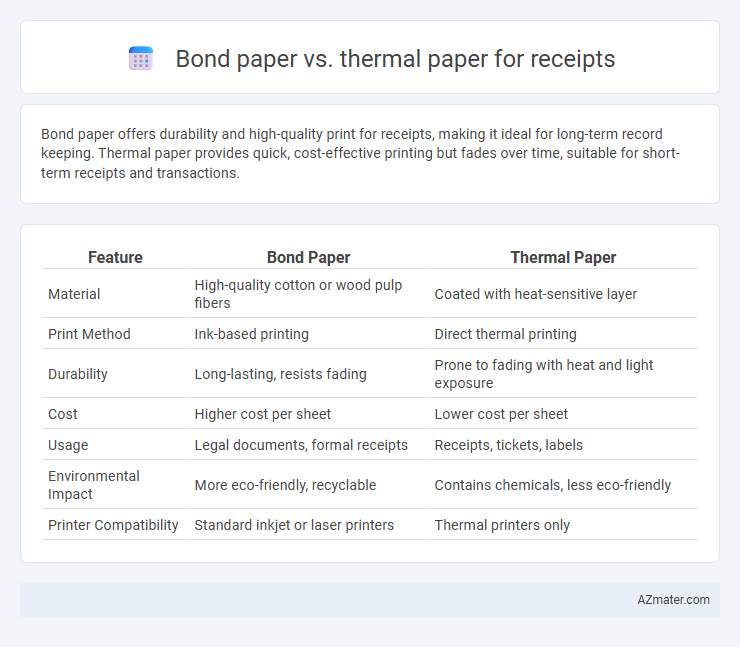Bond paper offers durability and high-quality print for receipts, making it ideal for long-term record keeping. Thermal paper provides quick, cost-effective printing but fades over time, suitable for short-term receipts and transactions.
Table of Comparison
| Feature | Bond Paper | Thermal Paper |
|---|---|---|
| Material | High-quality cotton or wood pulp fibers | Coated with heat-sensitive layer |
| Print Method | Ink-based printing | Direct thermal printing |
| Durability | Long-lasting, resists fading | Prone to fading with heat and light exposure |
| Cost | Higher cost per sheet | Lower cost per sheet |
| Usage | Legal documents, formal receipts | Receipts, tickets, labels |
| Environmental Impact | More eco-friendly, recyclable | Contains chemicals, less eco-friendly |
| Printer Compatibility | Standard inkjet or laser printers | Thermal printers only |
Introduction to Receipt Paper Types
Receipt paper types primarily include bond paper and thermal paper, each with distinct characteristics suited for different printing technologies. Bond paper, known for its durability and ability to withstand various environmental conditions, is commonly used with impact printers that transfer ink via a ribbon. Thermal paper, coated with heat-sensitive chemicals, is designed for thermal printers and produces images through direct heat, offering fast, quiet printing ideal for high-volume transactions.
What is Bond Paper?
Bond paper is a high-quality, durable paper made from rag pulp or wood fibers, often used for important documents and receipts requiring longevity. It features a smooth surface and excellent ink absorption, making it ideal for printed receipts that must remain legible over time. Bond paper is less susceptible to fading and can withstand handling, making it preferred for receipts in retail and financial transactions where permanence is essential.
What is Thermal Paper?
Thermal paper is a specialized paper coated with a chemical layer that changes color when exposed to heat, eliminating the need for ink or ribbons in receipt printing. It is widely used in point-of-sale (POS) systems due to its fast printing speed, durability, and cost-effectiveness for short-term records. Compared to bond paper, thermal paper offers greater efficiency for high-volume receipt printing but may fade over time or with exposure to heat and light.
Printing Technology Used for Bond and Thermal Paper
Bond paper for receipts primarily utilizes impact printing technology, such as dot matrix printers, where ink ribbon transfers characters onto the paper through mechanical force. Thermal paper employs direct thermal printing, relying on heat-sensitive coating that changes color when exposed to the thermal printhead's heat, eliminating the need for ink ribbons. The choice between bond and thermal paper influences printer maintenance, durability, and print quality due to their distinct printing technologies.
Cost Comparison: Bond Paper vs Thermal Paper
Bond paper is generally more affordable per sheet compared to thermal paper but requires ink or toner for printing, which adds to long-term costs. Thermal paper has a higher upfront price but eliminates ink expenses, making it cost-effective for high-volume receipt printing. Evaluating total operational expenses, including maintenance and consumables, thermal paper often proves more economical for businesses with frequent printing needs.
Durability and Longevity of Receipts
Bond paper receipts offer superior durability and longevity compared to thermal paper, as they resist fading and wear over time due to their sturdy composition and ink retention. Thermal paper receipts are prone to fading quickly when exposed to heat, light, or chemicals, making them less reliable for long-term recordkeeping. Businesses requiring durable receipts for audits or warranty purposes often prefer bond paper for its extended shelf life and improved readability.
Environmental Impact and Sustainability
Bond paper receipts typically use environmentally friendly materials, are recyclable, and may contain recycled content or be chlorine-free, reducing their environmental footprint. Thermal paper receipts often contain chemical coatings like BPA or BPS, which pose health risks and complicate recycling processes, leading to greater environmental harm. Choosing bond paper supports sustainability by enabling easier recycling and reducing toxic chemical exposure compared to thermal paper.
Print Quality and Legibility
Bond paper offers superior print quality and higher legibility for receipts due to its smooth surface and better ink absorption, resulting in crisp and clear text. Thermal paper, while cost-effective and fast for printing, may suffer from fading and discoloration over time, impacting long-term readability. For businesses prioritizing durable receipt readability, bond paper remains the preferred choice despite higher initial costs.
Use Cases: When to Choose Bond or Thermal Paper
Bond paper is ideal for receipts requiring durability, long-term archiving, or high-quality printing, such as official documents, invoices, or receipts needing a professional appearance. Thermal paper suits fast, cost-effective, and temporary receipts typically found in retail, restaurants, and transportation, where quick printing and immediate readability are essential. Choosing bond or thermal paper depends on the necessity for receipt longevity, print quality, and environmental conditions of the transaction.
Conclusion: Which Receipt Paper is Best for Your Business?
Bond paper offers durability, high print quality, and resistance to fading, making it ideal for long-term receipts and records; thermal paper provides cost-efficiency and fast printing with vivid images but can fade over time and is sensitive to heat and light. Businesses prioritizing archival-quality receipts and professional appearance benefit most from bond paper, while high-volume retail or food service operations aiming for speed and cost-effectiveness prefer thermal paper. Evaluating factors like receipt longevity, printing costs, and environmental conditions determines the best receipt paper choice for your specific business needs.

Infographic: Bond paper vs Thermal paper for Receipt
 azmater.com
azmater.com